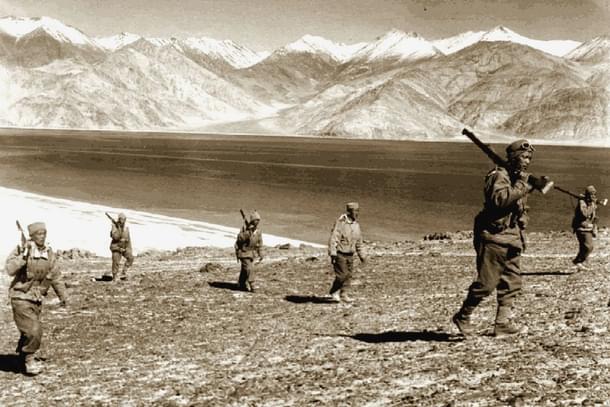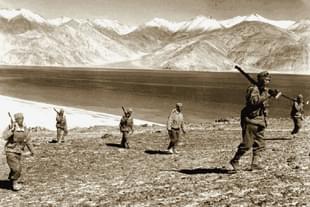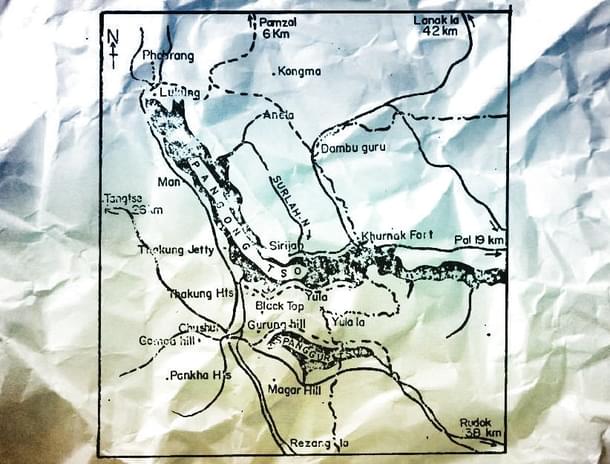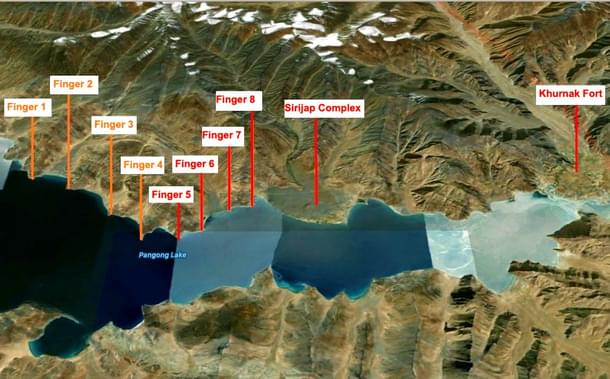Defence
Pangong Tso: How Major Dhan Singh Thapa And His Men Fought In 1962 To Defend The Area Where India-China Are Locked In A Stand-Off
Prakhar Gupta
Jun 07, 2020, 12:06 PM | Updated Oct 20, 2020, 01:25 PM IST
Save & read from anywhere!
Bookmark stories for easy access on any device or the Swarajya app.


In November 1961, amid increasing Chinese intrusion and construction in what India saw as its territory, a meeting was held at the Prime Minister’s Office.
Present at this meeting, among others, were Prime Minister Jawaharlal Nehru, Defence Minister V K Krishna Menon, Army Chief P N Thapar, Foreign Secretary M J Desai, and B N Mullick, the Director of Intelligence Bureau, who details the interaction in his book The Chinese Betrayal.
After being explained the position on the frontier, Nehru decided that “Indian forces should remain in effective occupation of the whole frontier from NEFA to Ladakh...by setting up posts or by means of patrolling”, Mullick writes.
This decision, India’s official war history records, “launched the Forward Policy”.
The policy was implemented without delay — instructions were issued by the Indian Army Headquarters in December 1961, and had a “major effect in determining the deployment in Ladakh”.
The plan, as far as Ladakh was concerned, was to “patrol as forward as possible...with the view of establishing additional posts...to prevent any further ingress by the Chinese” into Indian territory.
In effect, this directive meant that the Indian Army was to secure all possible approaches of ingress from Tibet towards Ladakh.
One such approach was from Khurnak Fort, near the northern bank of the Pangong Lake, where the Chinese had a major base, to Thakung in the southwest, and towards Chushul to the south.
Sirijap, which lies west of the Khurnak Fort on the northern bank of Pangong Tso, dominates this approach, and India decided to build posts here.

North of Pangong Lake lies the Chang Chenmo range. Spurs which jut out from this range, running mostly perpendicular towards the northern bank of the Pangong Lake, are called ‘fingers’ by the Indian Army.
These fingers are labelled 1 to 8 in a map of the lake’s northern bank below.
The area just east of Sirijap, between Finger 4 and 8 in the below map, is where India and China are currently locked in a stand-off (Read: Pangong Tso Stand-Off Explained: The Change In Status Quo By China That India Wants Reversed).

By October 1962, Chushul had an active airfield capable of taking An-12s and Packet aircraft, and thus it was critical for maintaining supply lines (India airlifted tanks to Chushul from Chandigarh on An-12s later that month).
Moreover, just before the start of the war, Chushul had been linked to Leh in the north with a jeepable road over the Taska La pass and along the Indus.
Therefore, for India, securing the Khurnak Fort-Thakung approach was important for the defence of Chushul and Leh.
India built three posts for this before the war — Sirijap, Sirijap 1 and Sirijap 2, together called the Sirijap Complex by the Indian Army.
In November 1962, these posts at Sirijap would meet the same fate as many others established along the China frontier under the Forward Policy, but not without a fierce fight in the face of certain defeat.
In the second week of October 1962, just days before the beginning of the war, a company less one platoon of the 1/8 Gorkha Rifles was deployed at the three posts of Sirijap Complex.
These posts had no land link with the Indian base east of the Pangong Tso and had to be supplied by boats from across the lake.
The Chinese had surrounded the Sirijap Complex as early as September of 1962.
Unlike the Sirijap Complex, the Chinese positions in the region — named Kong-9 and 10 by one account and located north and east of the Indian posts — were linked to their headquarters at Khurnak Fort by road.
Sirijap-1, one of the three posts part of the Sirijap Complex, was located on the ridge-line overlooking the Pangong Lake.
It was being defended by a company less two platoon, around 30 men, under the command of Major Dhan Singh Thapa.
Major Thapa, who had lost his daughter recently and had gone to Ladakh leaving his pregnant and grieving wife back home, had been granted leave for a week.
The officer sent to relieve him from the front had reached Leh.
But despite the permission to leave, military historian and storyteller Rachna Bisht Rawat writes in her book The Brave: Param Vir Chakra Stories, Major Thapa decided to stay put at Sirijap “since he did not want to leave his company headless” at a time when tensions were rising.
A few years ago, when his daughter was born, Major Thapa was out on an operation in insurgency-hit Nagaland.
As it turned out, he would not be home for the birth of his son.

The battle at Sirijap-1
While Delhi continued to remain in denial, drawing wrong lessons from an incident in the Galwan River Valley where the Chinese forces surrounded a small Indian post for months but did not attack, Major Thapa could see the signs of trouble from Sirijap.
Heightened activity on the Chinese side on 19 October alarmed Major Thapa, and he ordered his men to dig deep. The attack came in the wee hours on 20 October, when the People’s Liberation Army (PLA) concentrated a barrage of artillery and mortar fire on Sirijap-1 for nearly two-and-a-half hours.
Some shells fired by the Chinese fell on the command post, damaging the radio set, putting the only means of communication out of commission and cutting off the besieged post from the rest of the battalion.
“Signal Officer Major Ved Vyas will later recall the last message received from Major Thapa. ‘Neither will I withdraw, nor will I surrender,’ he said,” Rawat writes in her book.
Under the cover of the artillery and mortar shelling, the PLA forces advanced towards Sirijap-1. By the time the shelling was lifted, the Chinese forces had reached very close to the post.
The shelling “provided the necessary cover to allow the Chinese forces to move up to 150 yards to the rear of the post,” Major General Ian Cardozo writes in his book Our Heros In Battle, which records the fight at Sirijap in detail.
The shelling had not only damaged the defences, but had also killed and wounded many soldiers.
However, as the yelling and screaming Chinese charged towards the post, the soldiers, even those who were wounded, went into action.
Section Commander Naik Krishnabaduhar Thapa, who was “hit by a splinter that severed his leg”, took over a Light Machine Gun (LMG) after a soldier who was using it had been killed, and started firing towards the advancing Chinese.
A large number of Chinese were shot and the attack was broken up 100 yards from the post, Major General Cardozo says in his account of the battle.
Major Thapa, meanwhile, adjusted the depleted defences and encouraged the soldiers, dogging enemy fire as he moved from one place to the other.
“If we have to die we’ll all die together, but kill a few before you die. ‘Kafar hunu bhanda marnu ramro’ (It is better to die than be a coward),” he told soldiers, Rawat writes in her account of the battle based on interactions with Major Thapa’s family and retired soldiers.
Soon, the Chinese started artillery and mortar bombardment again, and it was more intense this time.
Under the cover of this shelling, the Chinese managed to come within 50 yards of the post. Crawling towards the post, they “commenced using incendiary bombs to set the post on fire and smoke out the defenders”.
The Gorkhas responded with hand-grenades and small arms fire.
Their .303 rifles and LMGs were no match to the weapons the Chinese were equipped with — the PLA prepared for months before invading India.
“The enemy now brought in heavy machine guns and bazookas and four amphibious crafts on the lake with each having a machine gun,” writes Cardozo.
The second-in-command at the post, Subedar Min Bahadur Gurung, crawled out of the debris of the bunker which had collapsed on him, with the LMG that he was manning still in his hand.
Injured and bleeding, Subedar Gurung started firing again, inflicting losses on the Chinese till the point he was killed.
Most Gorkhas, still in their early 20s, had very little experience.
They had lost most of their men, their defences were depleted, and the Chinese were closing in quickly.
But the surviving soldiers, now in single digits, continued to hold the post.
The only place from where the Sirijap post could be seen was the observation post at Thakung, which was used as a ferry point for boats deployed to maintain the posts in the Pangong Tso area.
From there, it looked as if Sirijap had been set on fire.
As there was no communication between the base and the post, the battalion decided to dispatch a party to find out what was happening at Sirijap.
Naik Rabilal Thapa, who was commanding another post, volunteered to go to Sirijap. With no road connection to Sirijap, he was sent towards the post with two storm boats to bring back the latest report from the troops posted there.
However, when the boats were around 1,000 yards away from Sirijap, the Chinese fired from three sides and capsized one, drowning all men on board. The other boat, with Naik Thapa on board, managed to return to the base, where he reported that Sirijap-1, engulfed in smoke and fire, had been lost, and all men defending it, including Commander Major Thapa, had died in the attack.
However, Sirijap-1 hadn’t been lost yet.
Some Gorkhas, along with Major Thapa, were still holding the post. Meanwhile, the Chinese, having been repulsed twice by the outnumbered Gorkhas, came back the third time, this time with light tanks.
The outnumbered Gorkhas were now outgunned — they had no weapon against the Chinese tanks.
The post had been reduced to smoke and rubble. With ammunition running out, three surviving Gorkhas, along with Major Thapa, pulled out their Khukris (traditional knife) and charged on the Chinese before being overpowered.
“Thapa was one of the last few alive and was fighting with his khukri when he was hit in the face by a rifle butt and lost two of his teeth. He killed the Chinese soldier and was in the process of putting out a fire by rolling over it physically when he was surrounded and taken prisoner,” Rawat writes in her book.
Sirijap-1 fell and Major Thapa was taken prisoner, but the war hadn’t ended for him.
Presumed dead by the Indian Army and awarded Param Vir Chakra posthumously, it would be months before Major Thapa’s family and the Indian state would find out that he was alive in Chinese captivity in Xinjiang, where he was tortured, put in solitary confinement, and subjected to aggressive and relentless Communist propaganda.
Thapa would reach home only in May 1963, seven months after he was taken prisoner, and how he managed to pull off this feat from a prisoner-of-war camp in Communist China, out of bounds for the Red Cross, is another story of his grit.
Thapa, as Major General Cardozo writes, “was neither the charismatic leader nor the fierce warrior. He in fact was the type that did his duty quietly and effectively without blowing his own trumpet or beating his own drum”.
He rejoined military service later that year and retired as Lieutenant Colonel.
Prakhar Gupta is a senior editor at Swarajya. He tweets @prakharkgupta.





